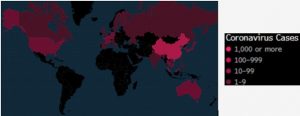We’re one month into 2020 and the year is already shaping up to be an eventful one. In early January the US and Iran were teetering on the brink of war following a US drone strike on an Iranian Major General. The assassination led to a retaliatory missile strike by Iran on US bases in Iraq. Diplomacy ultimately prevailed and the fervour surrounding the attack in a geopolitical sense quickly dwindled. By mid-January, the world’s attention was swiftly captured by Wuhan, China where news of a deadly influenza outbreak was starting to surface.

The coronavirus outbreak, now officially named COVID-19, is a developing story and will evolve as new information comes to light. At the time of writing (12/02/2020) the disease has infected 45 168 people and killed 1 115, suggesting a lethality rate of 2.5%, vs 0.1% for seasonal flu. This rate is lower than other major outbreaks (SARS: 10%, MERS: 34% & 1918 Spanish Flu: 10% to 20%) but it is more contagious. The contagious nature of coronavirus is what is distressing with the disease already claiming more lives than SARS did in 2003. Whilst the Chinese government has clamped down on their citizens in an attempt to quarantine the spread of the disease the fear is that the horse has already bolted.
For investors, beyond getting sick, what is there to be concerned about? Disaggregating the causes of market movements is difficult, but fears about the virus have been a large factor in the pullback in global equities in the last week of January. Looking at things more fundamentally, China is a global manufacturing powerhouse, and home to a significant proportion of the world’s middle-income consumer base. These individuals are economically active and purchase goods and services directly from multinational corporations listed across the world. If these factory workers and shoppers are quarantined at home, or simply put, too scared to go outside, the global economy will in all likelihood splutter, but at worst stall completely.
The next question to ask is, how is this affecting PortfolioMetrix portfolios? Coronavirus is a classic ‘black swan’ – an unexpected but high impact event. PortfolioMetrix portfolios are diversified because we can’t predict these events, thus we prepare for them in advance by building robust portfolios, rather than trying to react after the fact.
In addition, where mandates permit, we also select active managers who can react quickly to new information as it emerges which helps keep client portfolios nimble. It is likely, however, that portfolios will be volatile for the next few weeks. We are not planning any reactionary portfolio changes, but we are monitoring the situation closely.
PERFORMANCE FEEDBACK – JANUARY 2020
(Compiled by Nic Spicer and Russell Brown)
January Overview
In a surprise move the South African Reserve Bank unanimously cut interest rates by 25bps to 6.5%. This cut was carried out in the face of continued SoE woes, GDP growth downgrades, a bleak fiscus, poor employment data and a strained consumer. With inflation under control at 4%, the SARB’s hope is to stimulate growth in the economy so that budget deficits can be reined in. The conundrum surrounding whether South African Airways is a going concern remains. The national carrier has received support for its restructuring from the ANC and the Development Bank of South Africa which has thrown them a R3.5 billion lifeline. February is however going to be an interesting and telling month, President Ramaphosa’s State of the Nation Address (SONA) and Tito Mboweni’s budget speech are both being seen as pivotal moments in our country’s future.
The malaise of the local economy and a general flight from emerging market currencies over the course of the month is reflected in the depreciation of the rand. The rand lost significant ground against all major currencies. It appears that global investors are holding the rand at ransom until there is more clarity surrounding SONA, the budget and Eskom’s ability to keep the lights on.

At the end of January, the UK officially left the European Union, although this just signalled the start of the transition period during which trade agreements will be negotiated to try and avoid a hard Brexit at the end of 2020. All eyes will be on how these discussions evolve and on what they imply as to the nature of the future relationship between the UK and the EU from 2021 onwards. Most hard data releases in January still covered the period before the election, for example inflation dropping to 1.3% (and core inflation also falling, to 1.4%) in December. But there were positive forward-looking indicators during January, with the flash composite PMI figure rising from 49.3 in December (contractionary territory) to a relatively healthy 52.4 driven by stronger readings in both services and manufacturing. With this backdrop, along with other recent positive UK data and less Brexit uncertainty, the Bank of England maintained its current monetary policy stance. Markets had been pricing in a 50/50 chance of a rate cut, so this led to a slight bounce in the pound.
The recent thawing of trade tensions between the US & China was welcomed by markets. The next few months of data readings will be interesting to see the impact this has on business planning and subsequent activity. Early indications seem good as composite PMI readings continue to show increasing expansionary activity after an increase from 52 in November to 52.7 in December and the flash figure for January showing a further bump up to 53.1 driven by services, although manufacturing activity dipped slightly. The early reading of Q4 2019 annualised GDP was in line with expectations at 2.1%, although December’s non-farm payrolls were very slightly subdued with 145k new workers and a 10k downward revision to November’s number. With these broadly positive datapoints the US Federal Open Market committee unanimously voted to maintain the current level of monetary policy at its January meeting.
Europe’s flash Q4 quarter-on-quarter GDP was recorded at a marginally expansionary 0.1%, slightly below the consensus expectation of 0.2%. On the other hand, inflation did continue to tick-up towards target with December’s figure showing an increase to 1.3% (from 1% in November) and a flash estimate of January’s number at 1.4%. Unemployment dipped down slightly from 7.5% to 7.4% in December, the lowest level since May 2008. In addition, the composite PMI figure for December showed an increase to 50.9, slightly above market expectations. With data continuing to point broadly to improvements in the euro area, the ECB’s monetary policy committee voted to leave monetary policy unchanged in January. More interestingly, the ECB’s new president (Christine Lagarde) announced the launch of a full review of the ECB’s monetary policy strategy (due to be completed by the end of the year) which will cover their ‘price stability’ mandate (currently achieved by inflation targeting).
Japanese inflation surprised to the upside in December, rising to 0.8% from 0.5% in November, well above consensus estimates of 0.4%. Core inflation also rose in December. These numbers are still low but are at least on a positive trajectory, although it should be noted that this is still only around the same level as Q2 2019. Unemployment remained at 2.2% in December, slightly below expectation of 2.3%. However, composite PMI data for December showed a noticeable dip down to 48.6, from 49.8 the previous month – with both manufacturing and services activities both shrinking.
Asset Classes
Currency effects account for most of the disparity of returns observed below, with global asset classes denoted in rand having a stellar month. Money flowed out of risk assets, as investors grew wary of the impact coronavirus may have on the world economy. Safe-haven assets attracted these flows and US 10-year bond yields fell to 1.5%. Local Property was the worst performing asset class when measured in ZAR, investors remain cautious about economic growth in the country and oversupply in the market.
Below is a summary of performance of the broader asset classes for the month:

GPS PERFORMANCE FEEDBACK – JANUARY 2020
GBP Asset Classes and Currency Performance
The US was again the strongest performing equity region in sterling terms as markets experienced a classic flight to safety amongst coronavirus fears. Global listed infrastructure performed even better, as yields fell (which increased the value of the stable future cash flows of the asset class). EM equities and UK equities were the worst performing equity asset classes for the month, but global commodities performed even worse on the back of a collapse in the oil price, and other energy and basic materials.
Falling global bond yields, led to higher bond prices with long duration global inflation linked bonds performing very well. Riskier bonds were more subdued, but even high yield delivered a positive month.
GBP ASSET CLASS PERFORMANCE FOR THE MONTH

GBP CURRENCY PERFORMANCE FOR THE MONTH

USD Asset Classes and Currency Performance
The US dollar strengthened over the month against most developed currencies. As a result, asset class returns were less attractive when viewed in USD terms. The USD gained the most ground against the South African rand.
USD ASSET CLASS PERFORMANCE FOR THE MONTH

USD CURRENCY PERFORMANCE FOR THE MONTH

PROFILE PERFORMANCE – JANUARY 2020
Local Profile Performance
Period performance for the profiles as at the end of the month are shown below (all periods greater than a year are annualised):
REGULATION 28 PROFILE PERFORMANCE

DISCRETIONARY PROFILE PERFORMANCE



GPS Profile Performance
Period performance for the profiles as at the end of the month are shown below (all periods greater than a year are annualised):
PMX UCITS – GPS (GBP) PERFORMANCE



PMX UCITS – GPS (USD) PERFORMANCE




